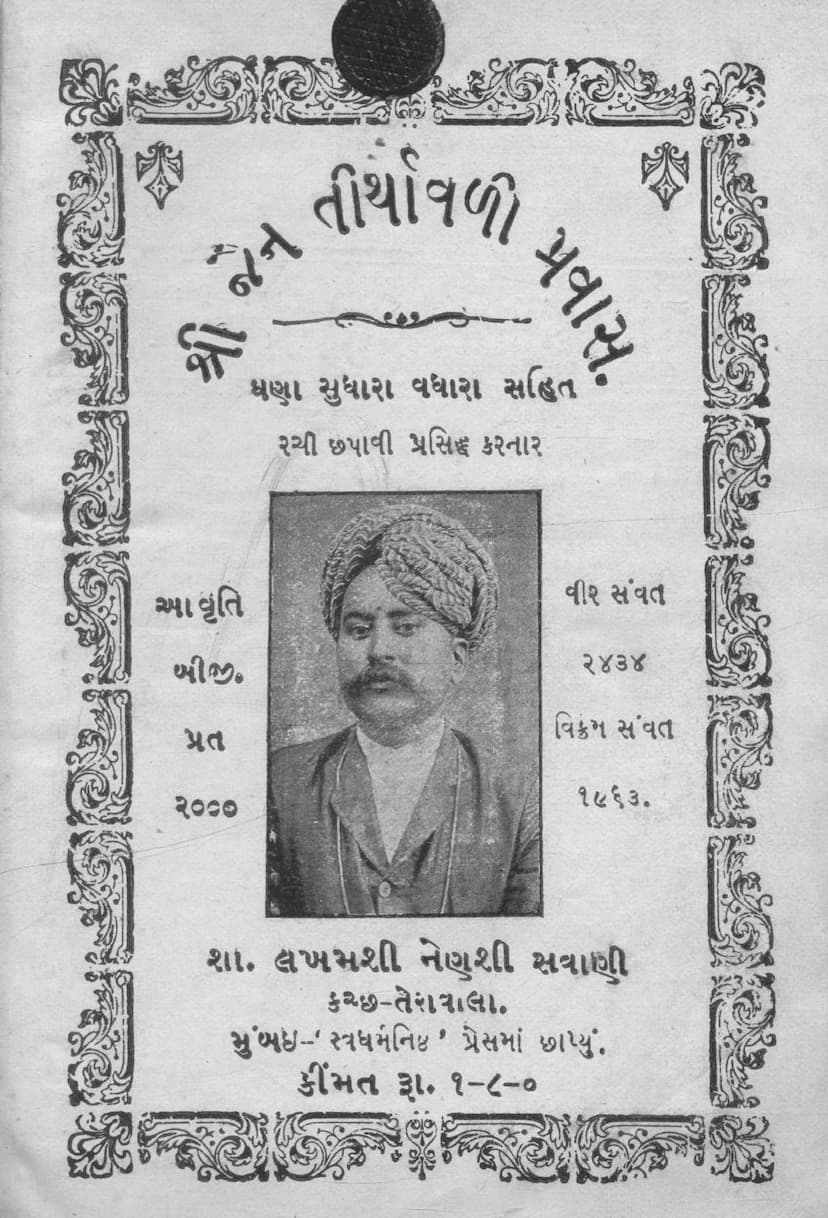Jain Tirthavali Pravas
Added to library: September 2, 2025

Summary
This document is the Jain Tirthavali Pravas (Travelogue of Jain Holy Places), authored by Lakhamshi Nenshi Savani. Published by the author himself, the second edition of this work, revised and expanded, was released in Vikram Samvat 2007 (1863 CE), corresponding to Vir Samvat 2434.
The book is registered according to the Copyright Act of 1857, with all rights reserved by the author.
Preface (Prastavana):
The author humbly informs the learned Jain community that there are numerous ancient and modern Jain holy sites (Tirths) in India and abroad. The scriptures describe the immense merit of pilgrimage, and the author affirms its truth, stating that the peace of mind attained at a holy site is difficult to find elsewhere. Therefore, pilgrimage is considered essential for spiritual progress.
The author notes that while many Jains undertake pilgrimages annually, there was a lack of a comprehensive guide in Gujarati to facilitate these journeys. This led to difficulties for pilgrims, preventing them from fully appreciating and visiting nearby Jain temples. Drawing inspiration from the experiences of his respected brother Dungarsi Bharmal, the author aimed to create a book that would simplify travel by detailing accessible routes and the locations of temples in various cities and villages.
This second edition is a significant expansion of the first, compiled with great effort and extensive research. The author expresses his hope that the book will be highly beneficial and fulfill its purpose.
Content and Scope:
The book is essentially a comprehensive directory of Jain pilgrimage sites, primarily in India. It lists hundreds of locations (indicated by numbered entries and corresponding page numbers). For each location, it provides information about the existence of Jain temples (Derasar), the condition of the temples (ancient, dilapidated, requiring renovation, newly built), the presence of dharamshalas (resthouses), jain shalas (schools), panjarapoles (animal shelters), and other relevant facilities.
The author also includes practical travel information, suggesting modes of transport (railway, bullock cart, walking), approximate distances, and sometimes the quality of the roads. He also mentions notable features of the pilgrimage sites, historical anecdotes, and the deities or Tirthankaras associated with them.
Key Features:
- Extensive Listing: The book covers a vast number of Jain Tirths, presented in a structured, indexed format.
- Practical Travel Guidance: It offers information on routes, distances, and transportation, making it a useful guide for pilgrims.
- Temple Information: Details about the condition, significance, and facilities available at each temple are provided.
- Historical and Religious Context: The author includes brief historical notes and mentions the Tirthankaras associated with specific sites, enhancing the reader's understanding.
- Author's Appeal: The author actively solicits further information from the Jain community to include in future editions, demonstrating a commitment to comprehensive coverage.
- Inclusion of Stanzas: The book features devotional stanzas (stavan) and prayers, adding a spiritual dimension.
- Guidance on Rituals and Conduct: Some sections touch upon purification rituals (sutak) and dietary considerations.
Purpose and Significance:
The "Jain Tirthavali Pravas" serves as a vital resource for Jain pilgrims, aiming to make their journeys easier, more organized, and spiritually fulfilling. By providing detailed information about numerous holy sites, it encourages more people to undertake pilgrimages and preserves the knowledge of these sacred places for future generations. The author's dedication to compiling such a detailed guide underscores the importance of these Tirths in Jainism.
Additional Information Provided:
- List of Other Publications: The author mentions other books published by him, including devotional works and a railway timetable.
- Medicinal Preparations: Savani also lists some medicinal preparations he offers.
- Rental Services: The author also mentions services for providing tents (talpatri) for Jain gatherings.
- Sutak Vichar: A section explains the rules of ritual impurity (sutak) related to births and deaths within the Jain tradition.
- List of Jain Tirthas: The bulk of the book is the extensive list of pilgrimage sites, meticulously cataloged.
- Devotional Stanzas: The latter part of the book includes various devotional stanzas (stavans) in Gujarati, dedicated to different Tirthankaras and holy sites.
- Information about Future Editions: The author expresses his desire for feedback to improve future editions.